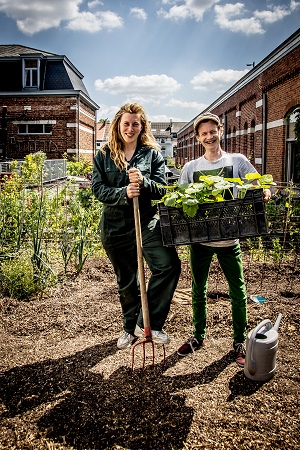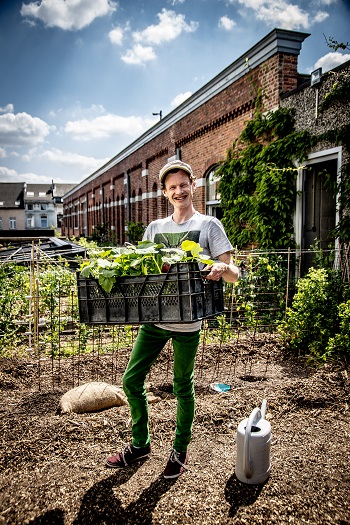Roof farmer Jonathan Van Houtte
In 2019, Sabien posted the following vacancy: ‘Roof Food is looking for a roof farmer’. Out of hundreds of applicants, Jonathan Van Houtte emerged as the perfect candidate. Born with a green thumb, passionate about both forest agriculture and urban agriculture, he has the knowledge and enthusiasm to inspire people to start working on their own projects. Jonathan: “I strongly believe in urban agriculture as the solution to tomorrow’s problems.”
 Sabien: “For the first three years of Roof Food, I took care of the roof garden myself. I did all the planting, fertilising, repotting, harvesting and everything else myself, although not in the way that I wanted. Because Roof Food got off to such a fast start, I had to arrange a lot of things so the roof garden itself always came in second place. I was more of an entrepreneur than a roof farmer. That’s a bit absurd, of course, because the garden is at the heart of the matter. When I received a subsidy from Circular Flanders in 2019 to map out Roof Food, I decided to post a vacancy for a roof farmer. I was looking for someone who could run the roof garden on a day-to-day basis, someone who could inspire others by sharing knowledge and who had an analytical and critical mind to conduct research into the ideal soil composition, the amount of water used, the yield, the suitable plant varieties, etc. So, all in all, it was a vacancy for a very versatile person!
Sabien: “For the first three years of Roof Food, I took care of the roof garden myself. I did all the planting, fertilising, repotting, harvesting and everything else myself, although not in the way that I wanted. Because Roof Food got off to such a fast start, I had to arrange a lot of things so the roof garden itself always came in second place. I was more of an entrepreneur than a roof farmer. That’s a bit absurd, of course, because the garden is at the heart of the matter. When I received a subsidy from Circular Flanders in 2019 to map out Roof Food, I decided to post a vacancy for a roof farmer. I was looking for someone who could run the roof garden on a day-to-day basis, someone who could inspire others by sharing knowledge and who had an analytical and critical mind to conduct research into the ideal soil composition, the amount of water used, the yield, the suitable plant varieties, etc. So, all in all, it was a vacancy for a very versatile person!
The response to the vacancy was huge. Being a roof farmer turns out to be a dream for many people. There was a large group of enthusiasts and hobbyists and a number of farmers who applied for the three-days-a-week position because of the financial security. Sabien: “I was looking for a passionate person with a strong long-term vision for roof gardening. Jonathan fully matched that profile. He was by far the best candidate.”
Vegetable gardening came naturally to Jonathan. As a little boy, he was able to experiment on a few square metres of soil in his grandfather’s vegetable garden. Jonathan: “I learned a lot from my grandfather about the different kinds of vegetables, how deep you have to plant them, how far apart they should be, what nutrients they need, and so on.” As an adolescent, he lost interest in agriculture and chose to go into construction. After his grandfather’s death, he watched his beautiful, large vegetable garden turn into a boring lawn. It sparked him to study forest management, and that’s when he discovered his true passion: food forests.
Jonathan: “Food forests are a perfect alternative to traditional, intensive farming, where annual sowing and fertilisation are needed. Food forests do not require cultivation. You plant a forest, leave it for twenty to thirty years, and you will have an abundance of natural products such as nuts, apples, pears, berries, acorns and chestnuts. They are also extremely interesting in terms of climate resilience. The plants have more time to root and can therefore get water from deeper in the ground. This is a big benefit in a changing climate with ever drier summers. The disadvantage of food forests is the long waiting time for results. Sometimes it takes up to fifteen years before they produce anything, yet once they start producing, the harvest quickly increases every year. Another disadvantage is that you get a lot of unknown, edible plants and shrubs which tend to make people turn up their noses. We don’t just need a change in our diet. Forget the annual crops such as carrots, tomatoes and leeks; we just need a change in our mentality. We’ll have to introduce people to many different kinds of edible plants. That’s why I started a food forest at home in Deinze [in Belgium] and a micro urban farm project called ‘De Proeftuin’ where I experiment with different plant species.”
When Jonathan saw the vacancy for a roof farmer, he was immediately enthusiastic. Jonathan: “I had already received several job offers, but they just didn’t appeal to me. I manage my vegetable garden without any pesticides or sprays. I don’t even use biological agents, which are equally harmful. I didn’t want to enter the organic sector or regular farming, and urban agriculture is right up my street. I strongly believe that urban agriculture can be the basis for the solutions to many of tomorrow’s problems. Look at all those roofs that are completely unused, when they could be so green and produce so much food. That challenges me. I want to encourage people to eat healthier and that starts by informing them about how vegetables are grown.
 So yes, I was overjoyed when I was hired. From the first meeting, it clicked with Sabien. I love her gentle approach. I can say anything to her and I never have the feeling that she is my boss. She gives me freedom and trusts me completely. I also find it very cool that Sabien is so interested in our research. I also have a critical view and enjoy indulging in the research we conduct here. We ask questions such as: ‘Is there any point in what we are doing here on the roof?’, ‘How many litres of water do we use?’, ‘Which plants grow well at this height and which don’t?’ and ‘Is 30 cm of granulate sufficient to collect the water?’ All in all, there is so much more to discover! The intention is to use all of the knowledge we have gained in future projects.”
So yes, I was overjoyed when I was hired. From the first meeting, it clicked with Sabien. I love her gentle approach. I can say anything to her and I never have the feeling that she is my boss. She gives me freedom and trusts me completely. I also find it very cool that Sabien is so interested in our research. I also have a critical view and enjoy indulging in the research we conduct here. We ask questions such as: ‘Is there any point in what we are doing here on the roof?’, ‘How many litres of water do we use?’, ‘Which plants grow well at this height and which don’t?’ and ‘Is 30 cm of granulate sufficient to collect the water?’ All in all, there is so much more to discover! The intention is to use all of the knowledge we have gained in future projects.”
Sabien: “I’ve noticed that there is indeed a great need for knowledge. Roof Food is a pioneering project. You can’t just build a vegetable garden on any roof. With Roof Food, we want to create impact and inspire people to take the initiative themselves. Where Jonathan gives concrete advice on everything that has to do with vegetable gardening, I give advice on the concept of roof gardening. It’s this combination that I like so much. Jonathan is an expert when it comes to nature. He has the practical knowledge from the field. I, on the other hand, have more of an entrepreneurial mentality. My strong point is bringing about social change. I dream of starting a kind of Roof Food academy with workshops where people can learn how to become roof farmers. Working together with Jonathan, I can totally see that happening. The dynamics between us are very good. We complement each other well and it feels good to look at things from our own perspectives. We pick up on each other’s ideas and improve them.”
This story was created with the support of Circular Flanders, the Flemish policy-making organisation for a circular economy.


Leave a reply